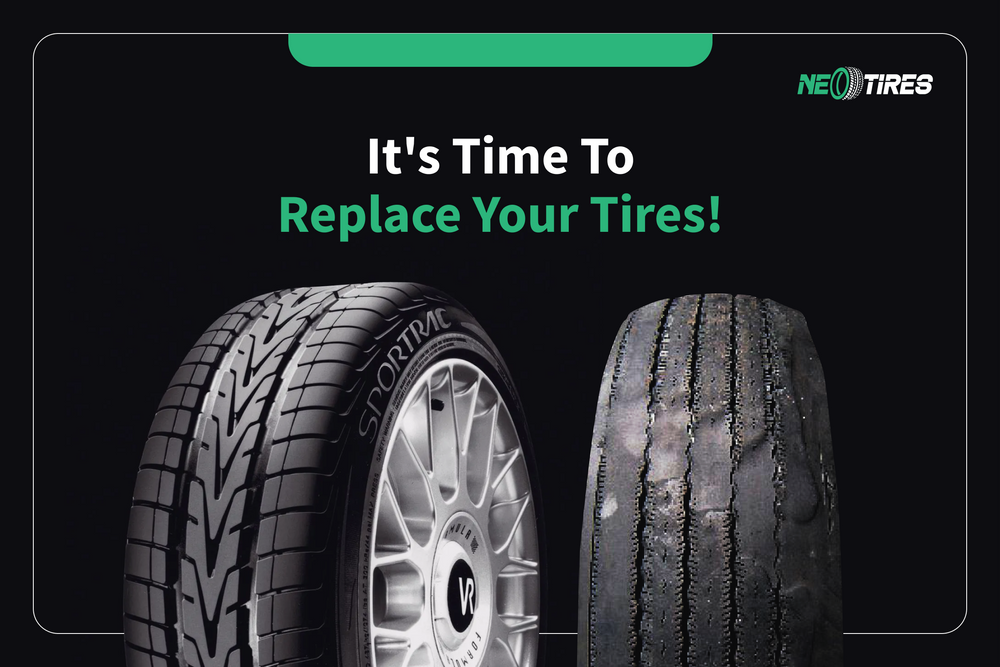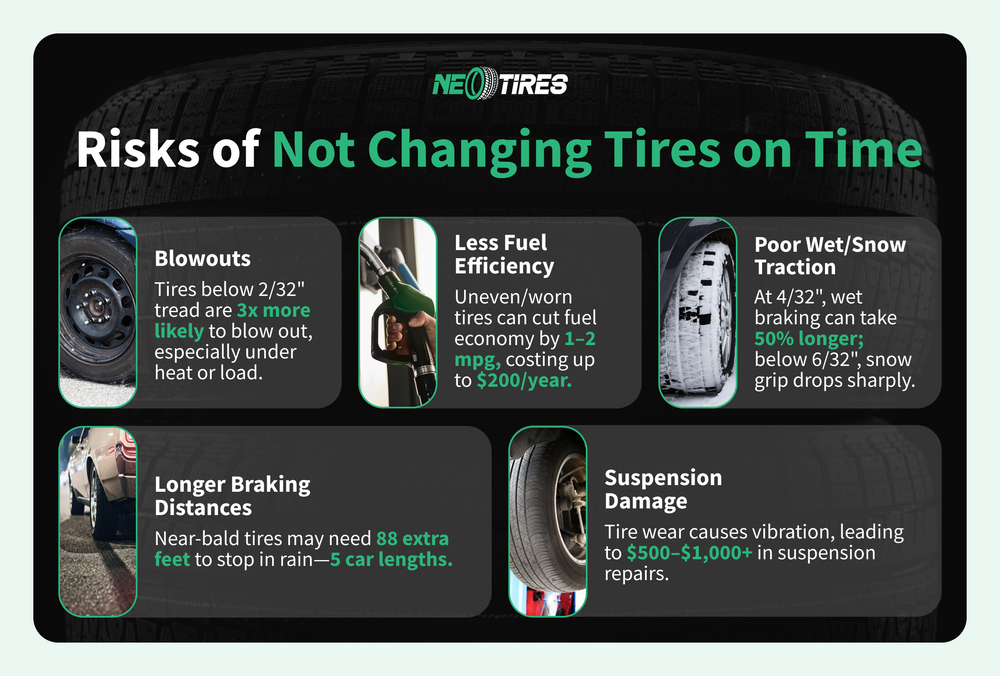Tires are subject to constant stress on every road trip, sharp corner, or aggressive braking. They wear out, and sooner or later, you need to replace tires. Understanding when to change your tires is not just about how much mileage you've put on them. It's about reading their symptoms and taking actions for safety and performance on any road you tackle.
In this section, we'll take a closer look at When Should You Replace Tires. We'll go beyond mileage, as how often to replace tires depends on their condition, not only on the miles covered. Let's find out the signs that tell it's time for tire replacement, as they can predict the change sooner than you think.
When to Replace Tires
When to change tires depends on four primary factors: their age, mileage, tread depth, and condition. You should replace tires when whichever of these factors shows first.
Replace them at least once every ten years (between 6 and 10), even if the condition and tread depth still seem viable. Big industry names like Michelin, Bridgestone, and Continental advise against using tires for longer periods as the rubber becomes brittle and performs poorly.
Tire replacement is necessary when the tread is below 2/32'', regardless of age. Exposure to aggressive driving or rough terrain conditions can accelerate tire wear, requiring earlier replacement.
For safety and performance reasons, replace tires within their average life expectancy. Most manufacturers provide treadlife warranties for each type of tire. All-season tires, for example, last about 50,000-80,000 miles, depending on brand and driving style.
Lastly, you should change your tires when you see signs of severe damage, such as cracks, bulges, or blisters. Symptoms such as vibrations or uneven wear patterns may also suggest the need for replacement of one or more tires.
When to Change Tires: Real-Life Scenarios
Tread Depth is Too Low
Low tread depth is one critical reason for low performance, as it reduces grip on both dry and wet roads. The legal limit for tread depth is 2/32", but we recommend considering replacing at 4/32" for safe wet driving and 6/32" for safe snow traction. Use the Penny Test to measure your tread depth. If Lincoln's head is fully visible, don't delay tire replacement.
Tires Are Over 6 Years Old
Rubber naturally degrades with age due to oxidation, drying, and heat cycles. Even though tires still look fine, they get brittle and hard, leading to severe cracking and splitting under pressure. Check the DOT code on your tire sidewall to find out the tire's age.
| Tire Age | Recommended Action |
| 0–5 years | Routine inspections |
| 6–10 years | Consider replacement regardless of tread |
| 10+ years | Replace immediately |
You See Cracks, Dry Rot, or Bulges
Signs of compromised tire structure include cracking, bulging spots, feathering, missing rubber chunks, or uneven tire wear. These reduce vehicle performance and increase the risk of blowouts. Consult a specialist to assess the severity of the damage and change your tires if the risk is imminent.
You Feel Excessive Vibration While Driving
It's common for damaged tires to show up through the steering wheel, causing vibrations, handling issues, and/or wobbling. First, a thorough inspection can reveal uneven wear, flat spots, alignment, or balance issues. If so, take necessary action, such as wheel alignment, tire rotation, or flat tire repair. However, if vibration and wobbling persist in the absence of other technical/mechanical vehicle issues, a full tire replacement can potentially resolve the problem.
What Happens If You Replace the Tires Later?
Tire replacement is not a whim but a necessity, ensuring driving safety, performance, and efficiency. Rolling on aged or damaged tires increases the risk of a blowout, poor wet and snow traction, low fuel efficiency, longer stopping distances, and suspension damage. Knowing when to change tires helps prevent these risks, ensuring a safer and more confident driving experience.
Risk of Blowouts
Old/worn tires are more susceptible to sudden failures, especially at high speeds and in hot climates. The tire's internal structure weakens, making it vulnerable to pressure and heat build-up.
Replace tires on time to prevent life-threatening situations. A tire blowout at 70 mph will likely cause complete control loss.
Poor Traction in Wet or Snow Conditions
The tread depth determines the traction capacity on wet or snowy roads. In rainy conditions, tires lose grip when the tread depth drops below 4/32''. The lower the grip, the higher the hydroplaning tendency. Replace tires at 4/32'' and 6/32'' for safe performance and dependable grip in wet and snowy conditions.
| Tread Depth (inches) | Wet Grip | Snow Performance | Risk Level |
|---|---|---|---|
| 6/32"–10/32" | Excellent | Excellent (snow tires often start at 10/32") | Safe |
| 5/32" | Very good | Good | Monitor tread if driving in snowy regions |
| 4/32" | Reduced | Marginal | Increased stopping distance in wet and snow |
| 3/32" | Poor | Unsafe | Loss of grip in winter and wet conditions |
| 2/32" (legal minimum) | Very poor | Extremely unsafe | Risk of hydroplaning and no snow traction |
Less Fuel Efficiency
Driving on worn, aged tires makes the engine work harder. This translates into higher rolling resistance and more fuel burning, respectively.
Longer Braking Distances
Tires play an essential role in vehicle braking through their composition and the way they grip the road. Shallow tread or brittle rubber increases the braking distance up to 2 times, especially on wet surfaces.
Suspension Damage
Delay in tire replacement can wear down other vehicle components, especially shocks, alignment details, and steering parts. Knowing when to change tires can save you from expensive repairs.
Tire Replacement: FAQs
Is it OK to Replace Just One Tire when Changing Tires?
Replace all four tires for maximum performance and safety. If driving an FWD or RWD vehicle, change at least two. Changing only one tire is acceptable if the condition of the rest is still good, with wear not higher than 30%. In such cases, the new tire should go on the rear axle.
Can I Put 2 New Tires On The Front?
If replacing only two tires, the new tires should be mounted on the rear axle.
Why Put New Tires On The Rear?
Regardless of the vehicle's traction system, the new tires should go on the rear axle. This allows better controllability, less hydroplaning tendency, and less skidding on winter roads.
Got Questions on When To Change Tires?
Understanding when to change tires is half the success. Finding the right replacement ones is the other half. At NeoTires, we combine fair prices with high quality to improve your driving experience. We take your needs and budget seriously and offer the best deals to meet your unique driving conditions and performance expectations. Explore our catalog or get instant support with personalized recommendations with just one click.
Drive safe and choose your tires wisely!







